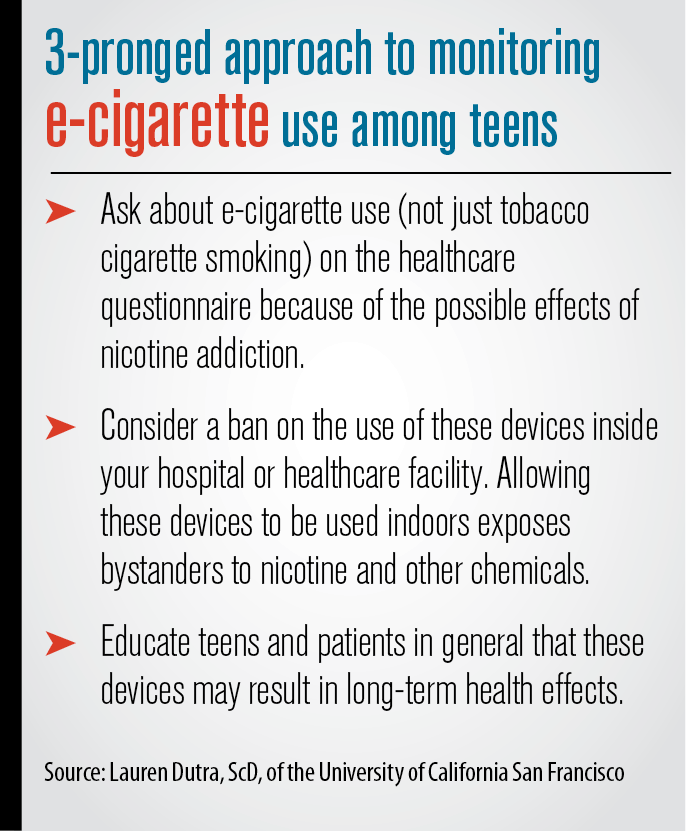- Safety & Recalls
- Regulatory Updates
- Drug Coverage
- COPD
- Cardiovascular
- Obstetrics-Gynecology & Women's Health
- Ophthalmology
- Clinical Pharmacology
- Pediatrics
- Urology
- Pharmacy
- Idiopathic Pulmonary Fibrosis
- Diabetes and Endocrinology
- Allergy, Immunology, and ENT
- Musculoskeletal/Rheumatology
- Respiratory
- Psychiatry and Behavioral Health
- Dermatology
- Oncology
[INFOGRAPHIC]: E-cigarette use tied to smoking in teens
E-cigarette use is associated with cigarette smoking among teens, according to a study in JAMA Pediatrics.
E-cigarette use is associated with cigarette smoking among teens, according to a
in JAMA Pediatrics.
Center for Tobacco Control Research and Education postdoctoral fellow Lauren Dutra, ScD, of the University of California San Francisco, and colleague Stanton Glantz used data from the Centers for Disease Control and Prevention (CDC) to show that e-cigarette use among adolescents is increasing rapidly and these teens are also smoking conventional cigarettes. E-cigarette use recently doubled among teens, from 3.3% in 2011 to 6.8% in 2012.
Dutra and Glantz analyzed the CDC data from a cross-sectional survey (snapshot in time) administered to more than 17,000 U.S. middle and high school students in 2011 and more than 22,000 teens in 2012. The researchers noted that these are two separate samples-the same adolescents were not necessarily sampled both years.
The researchers found that among US middle and high school students in 2011 and 2012:
• E-cigarette users were more likely to be tobacco cigarette smokers.
• Smokers of both e-cigarettes and conventional tobacco cigarettes were more likely to be planning to quit smoking tobacco cigarettes but less likely to have actually stopped smoking tobacco cigarettes.
• Cigarette smokers who also used e-cigarettes were actually heavier cigarettes smokers (smoked more tobacco cigarettes per day).
“We saw rapidly increasing levels of e-cigarette use among teens [~3% in 2011 and ~6% in 2012],” said Dutra. “We didn’t see any proof that e-cigarettes are helping adolescents in the United States stop smoking conventional tobacco cigarettes, and we saw very high levels of dual use-using both e-cigarettes and conventional tobacco cigarettes.”

“We wanted to show that adolescents who used e-cigarettes were more likely to be cigarette smokers and more likely to progress from experimenting with cigarettes to becoming regular cigarette smokers,” Dutra continued. “E-cigarette users, despite having higher reports of planning to quit smoking than non-e-cigarette users, were less likely to have stopped smoking cigarettes and were heavier cigarette smokers."
These findings call into question whether e-cigarettes are effective smoking cessation tools for adolescents, according to the researchers.
“Be aware that e-cigarette companies are targeting adolescents by making candy-flavored e-cigarette vapor and creating advertisements that target youth,” Dutra said. “Do your research on these products, and proceed with caution. Because these products are not regulated by FDA, the e-cigarette companies are making a lot of claims that may be unsubstantiated. Nicotine levels and other information on ingredients may be inaccurate as well. Support bans on ads, flavors, and other marketing techniques used by e-cigarette companies to target.”
Related article:
Will other chain pharmacies follow CVS in banning the sale of cigarettes?
FDA Issues Complete Response Letter for Pz-Cel to Treat Epidermolysis Bullosa
April 22nd 2024Prademagene zamikeracel is a cell therapy designed to incorporate the functional collagen-producing COL7A1 gene into a patient’s own skin cells. The FDA is asking for additional information on manufacturing practices.
